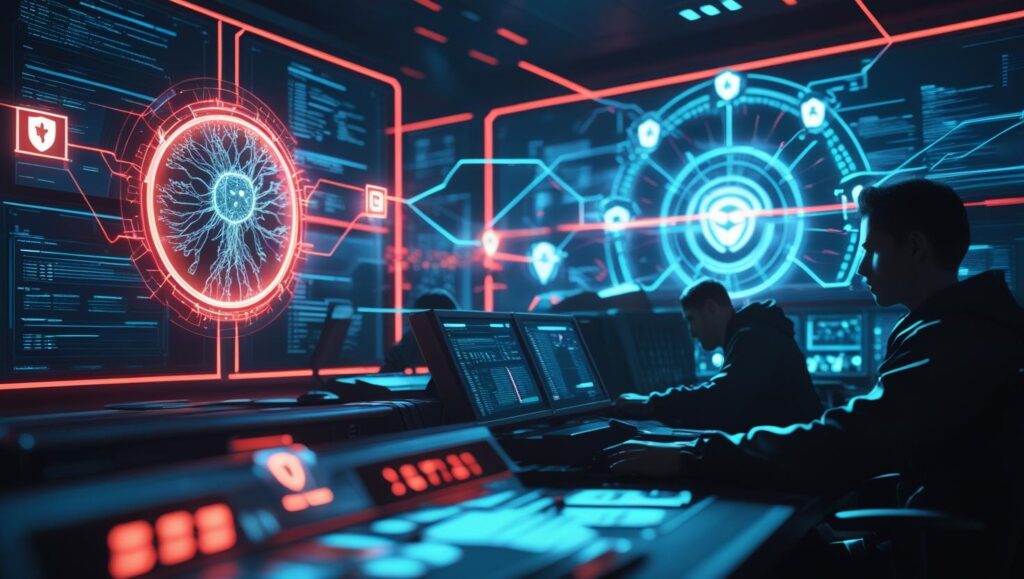Imagine guarding a digital castle in 2025 — but every night, new tunnels are silently being dug beneath your walls. You wake up never quite sure where the breach is or who’s behind it. That’s the reality facing cybersecurity teams today.
Table of Contents
ToggleHow AI Is Changing Cybersecurity
As AI evolves at breakneck speed, the battle is no longer just hackers vs. humans — it’s AI vs. AI. Cybercriminals are leveraging automation, deepfakes, and behavior-cloning, while security pros are building smarter defenses, faster response tools, and predictive systems that think ahead.
So what does the modern battlefield actually look like? Let’s take a closer look.
AI vs. AI: The Cyber Arms Race Is Real
Just a few years ago, a firewall and your trusted antivirus program were enough to sleep soundly. In 2025? That’s wishful thinking.
Today’s cybersecurity is a full-on algorithm war
Offensive AI
Offensive AI tools create hyper-personalised phishing emails, break passwords in seconds, and simulate real user behaviour to sneak past traditional defences.
Deffensive AI
Defenders, on the other hand, are using AI to flag suspicious patterns, stop intrusions mid-flow, and even predict attacks based on behavior analytics.
📌 Real example: Earlier this year, several global banks faced “phantom logins”—bots ”mimicking the exact keystroke and login rhythm of their CEOs. Traditional systems missed it. AI-powered behavior models didn’t.
👉 Also read: Top AI Trends That Will Disrupt Startups in 2025—explore how AI is transforming more than just cybersecurity.
Smarter Threat Detection: Goodbye, Rulebooks
Old-school security systems worked on logic like: “If X happens, trigger Y.” But hackers now rewrite the rules daily — that approach just can’t keep up.
That’s where AI earns its stripes. It scans millions of data points in real time, adapts to changing behavior, and catches the weird stuff no static rulebook could ever anticipate.
🛡 Case in point: A fintech startup avoided a million-dollar loss when its AI system flagged logins from four countries within minutes of each other. It was so subtle, most humans would’ve missed it. The AI didn’t blink.
🔗 Related read: Define Pwned—Massive Password Leak Exposes Billions—Learn how to protect yourself from credential theft.
Meet the AI-Powered SOCs
Security teams are drowning in alerts—most of which lead nowhere. AI copilots for Security Operations Centers (SOCs) are stepping in as digital assistants that:
- Summarize incidents in seconds
- Highlight the few threats that actually matter
- Recommend immediate fixes
Picture this: It’s 9:30 a.m., and your SOC has already flagged 1,500 alerts. You’d normally spend hours triaging them. But your AI assistant just flagged one login attempt that doesn’t align with historical behavior—and it’s coming from your CFO’s device.
That’s the difference between catching the real threat and missing it completely.
🛠 Tool highlight: Platforms like Microsoft Copilot and CrowdStrike Charlotte AI are now core to many modern SOCs—helping teams act faster and reduce alert fatigue.
🚀 Explore: 10 Free Tools Every Startup Should Use—including top AI security picks to boost your startup’s defenses
Deepfakes & AI Scams Are Getting Smarter Too
While AI is supercharging cybersecurity, it’s also giving scammers terrifying new tools.
In 2025, deepfake videos, cloned audio calls, and chatbot impersonators are pulling off scams that seem ripped from a Netflix thriller.
Real-world examples include:
- Voice-cloned calls impersonating CEOs
- AI-generated chats simulating urgent finance requests
- Synthetic videos requesting sensitive access or fund transfers
I even spoke to a founder last quarter who received a Slack message from “himself,” asking IT to reset a password. It was a deepfake — and it nearly worked.
The new defense? Biometric verification, communication behavior analysis, and AI models that understand context.
🧩 Insight: In a world where anyone’s voice or face can be faked, identity itself is fragile. Defending it means thinking like a machine, and verifying like a human.
What’s Next? AI Is Rewriting the Security Playbook
AI’s influence isn’t stopping at detection. It’s now baked into how security systems — and even code — are being written and deployed.
Here’s what’s coming fast:
- AI writing secure code in real-time as developers type
- Machine-learning honeypots that lure hackers into exposing techniques
- Zero-trust networks dynamically approving access based on behavioral AI analysis
It’s exciting—and yes, a little unnerving—to think AI might soon write security policies better than most humans.
🧠 Big Thought: In a world where identity, behavior, and access all blur together, the best defenses will be the ones that learn and evolve just as fast as the attackers do.
TL;DR – What You Need to Know
- AI is both sword and shield in the cybersecurity battlefield
- Threat detection is smarter, but so are the scams
- Deepfake-proof defenses rely on biometrics and behavior analytics
- AI-first security isn’t optional—it’s your new baseline.
💬 What’s your biggest cybersecurity concern in the AI age? Drop your thoughts in the comments or check out our AI Tools section for hands-on protection.
Frequently Asked Questions (FAQ)
👤 Author Bio
Written by the SevenFeeds Team—we bring you founder-focused tech insights, tools, and stories from the frontlines of innovation. Got a topic in mind? Email us at info@sevenfeeds.com.
📩 Say hi at info@sevenfeeds.com
